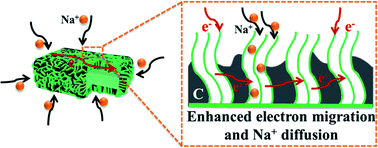Self-templated induced carbon-supported hollow WS2 composite structure for high-performance sodium storage†
Abstract
Building composite structures of hollow metal sulfides and carbon material is considered an effective strategy for improving the performance of sodium storage. However, most of these composite structures are implemented using complex hard-templating and multiple-step methods. Moreover, the mechanism for enhancing the electrochemistry of carbon materials in hollow structures is not clear. In this work, a carbon-supported hollow tungsten disulfide (WS2) cuboid composite structure (marked H-WS2) was synthesized in one step by a self-templating method. On the one hand, the hollow composite structure can alleviate the volume changes during the charging and discharging processes, showing good structural stability. On the other hand, the pyrolytic carbon and nanosheet structure can effectively promote the transport of electrons/ions, exhibiting fast reaction kinetics. The H-WS2 electrode showed improved electrochemical performance for sodium storage. A high reversible capacity was achieved, 353.2 mA h g−1 after 100 cycles at 200 mA g−1. At a high current density of 5.0 A g−1, the reversible capacity of 236.7 mA h g−1 was still achieved. This work provides new insight into the synthesis of hollow metal sulfides and carbon composite structures.



 Please wait while we load your content...
Please wait while we load your content...